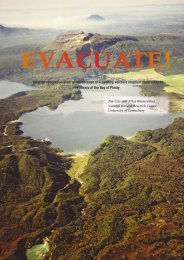Volcanoes - Ministry of Civil Defence and Emergency Management
Volcanoes - Ministry of Civil Defence and Emergency Management
Volcanoes - Ministry of Civil Defence and Emergency Management
You also want an ePaper? Increase the reach of your titles
YUMPU automatically turns print PDFs into web optimized ePapers that Google loves.
1976) <strong>and</strong> conflicts over staff priorities between research<br />
<strong>and</strong> monitoring requirements.<br />
Egmont<br />
Network<br />
In February 1995, there was a major <strong>of</strong>fshore<br />
earthquake on Waitangi Day, <strong>and</strong> GNS had difficulty<br />
in providing accurate information with the minimal<br />
network <strong>of</strong> real-time seismometers available. GNS<br />
therefore initiated a review <strong>of</strong> capability requirements<br />
while simultaneously seeking funding for such a system.<br />
Leadership <strong>and</strong> funding for this purpose were eventually<br />
provided by the Earthquake Commission <strong>and</strong> in 2001<br />
the GeoNet Project was launched. Almost three years<br />
on, GeoNet is improving the detection, data gathering,<br />
<strong>and</strong> rapid response related to New Zeal<strong>and</strong> earthquakes,<br />
volcanic activity, large l<strong>and</strong>slides <strong>and</strong> the slow<br />
deformation that precedes large earthquakes. GeoNet<br />
will enable responding agencies to provide a much<br />
better service to the community during earthquake <strong>and</strong><br />
volcanic crises, <strong>and</strong> provide the high quality data needed<br />
for modern research to advance societies’ underst<strong>and</strong>ing<br />
<strong>of</strong> geological hazards.<br />
VOLCANO-SEISMIC NETWORKS<br />
Cracking <strong>of</strong> rocks under stress from magma<br />
produces small earthquakes, similar to those seen<br />
in non-volcanic areas. But particularly indicative <strong>of</strong><br />
impending volcanic activity are volcanic earthquakes<br />
<strong>and</strong> tremors. A normal small earthquake will have a<br />
vibration frequency <strong>of</strong> about 10 times a second (10 Hz),<br />
but volcanic earthquakes are much slower, about 1 or<br />
2 Hz. Some volcanic earthquakes are single events, but<br />
Auckl<strong>and</strong><br />
Network<br />
Taupo<br />
Network<br />
Volcano-Seismic Networks for major New Zeal<strong>and</strong> volcanoes.<br />
Rotorua–BOP<br />
Network<br />
Tongariro<br />
Network<br />
Mayor Isl<strong>and</strong><br />
at many volcanoes there is continuing low-frequency<br />
vibration, known as volcanic tremor. Scientific debate<br />
continues about the actual cause <strong>of</strong> these events, but<br />
they definitely seem to be related to fluids, especially<br />
fluids moving underground. At most volcanoes, an<br />
increase in the energy <strong>of</strong> volcanic earthquakes <strong>and</strong>/or<br />
tremor precedes eruptions. The Ruapehu volcano is a<br />
little anomalous in having long periods <strong>of</strong> tremor that do<br />
not precede eruptions, which makes it harder to use the<br />
tremor level by itself as an indication that an eruption<br />
is near. At some overseas volcanoes, another variety<br />
<strong>of</strong> seismic event, called a “tornillo” (Spanish for screw),<br />
with a sharp onset <strong>and</strong> regular slow decay, is noted as<br />
occurring before eruptions. We began to observe them<br />
under Tongariro in 2000, but so far there have been no<br />
eruptions.<br />
Seismic networks have now been established<br />
for all the major volcanoes in New Zeal<strong>and</strong>. The<br />
networks that extend from the Tongariro National Park<br />
volcanoes, through Taupo <strong>and</strong> Rotorua to the Bay <strong>of</strong><br />
Plenty, together with a station on White Isl<strong>and</strong> volcano<br />
are operated by GNS, while networks on Mt. Taranaki/<br />
Mt. Egmont <strong>and</strong> the Auckl<strong>and</strong> volcanoes are operated<br />
by the Taranaki <strong>and</strong> Auckl<strong>and</strong> regional councils. All<br />
these networks are linked for real-time analysis <strong>of</strong> the<br />
recorded signals by GNS staff at the GeoNet data centres.<br />
Any earthquakes near an active or dormant<br />
volcano will be looked at in terms <strong>of</strong> their possible<br />
connection with volcanism. At the frequently active<br />
volcanoes, seismicity can rapidly develop into an<br />
White Isl<strong>and</strong><br />
eruption. For instance, both<br />
the 1969 <strong>and</strong> 1975 eruptions<br />
<strong>of</strong> Ruapehu were preceded<br />
by volcanic earthquakes <strong>of</strong><br />
increasing size during the<br />
space <strong>of</strong> less than half an<br />
hour. The 1996 Ruapehu<br />
eruption commenced several<br />
days after strong anomalous<br />
tremors that resulted in<br />
warnings being issued. For<br />
the volcanoes <strong>and</strong> calderas<br />
that have been quiet for<br />
hundreds <strong>of</strong> years or longer,<br />
it is likely that there would be<br />
a longer period <strong>of</strong> warning.<br />
A particularly worrying<br />
pattern would be seismicity<br />
that got shallower over weeks<br />
or months, as magma rose. It<br />
is also necessary not to overreact<br />
to seismic events. For<br />
instance, the Rotorua area<br />
frequently has swarms <strong>of</strong> 50<br />
13<br />
TEPHRA<br />
June 2004

















